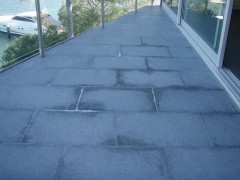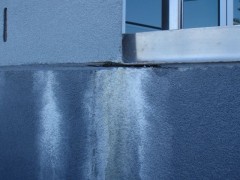Efflorescence
What is Efflorescence?
Efflorescence is the formation of insoluble salts that appear as white coloured staining on tiles, concrete, brickwork and stone and is generally considered as a building defect. There are 2 main types of efflorescence:
- Primary efflorescence due to the hydration process during the setting of cement; and
- Secondary efflorescence due to free water of a cementitous material allows soluble salts to migrate to the surface, with the free water evaporating forming insoluble salts (efflorescence).
How is Efflorescence Formed?
Ceramic tiles, stone and pavers are generally laid on concrete or leveling screeds that are of a cementitous material which include the constituents of efflorescence. These cementitous products are an abundant source of calcium hydroxide [Ca(OH)2] which is formed during the cement hydration process.
The presence of free water such as rain may penetrate through the grout lines or into the ceramic tiles, stone and pavers may then dissolve the calcium hydroxide. If this salt water is then allowed to evaporate over time, the soluble calcium hydroxide may react with the carbon dioxide (CO2) in the air, forming an insoluble calcium carbonate (CaCO3) that forms the efflorescence. It is at these places of evaporation that high levels of the white coloured efflorescence are observed.
Efflorescence Testing Australian Standard AS/NZS 4456.6
Masonary and stone pavers may also be tested to determine their propensity to migrate salt laden solution and form efflorescence at the surface. The pavers and stone are partially submersed into a salt solution and observed over time to assess how any efflorescence and the extent. Safe Environments conduct efflorescence testing to AS/NZS 4456.6 Masonry units and segmental pavers and flags – Methods of test – Determining potential to effloresce.
How to Prevent and Mitigate Efflorescence?
Primary efflorescence may not be able to be completely eradicated and initial cleaning should remove the majority of initial efflorescence. However secondary efflorescence can be prevented by sound design practice and construction techniques which include:
- Minimising water penetration into the ceramic tile, stone or paver system for the calcium hydroxide to dissolve; and/or
- Ensuring adequate substrate drainage to prevent salt laden water from evaporating.


